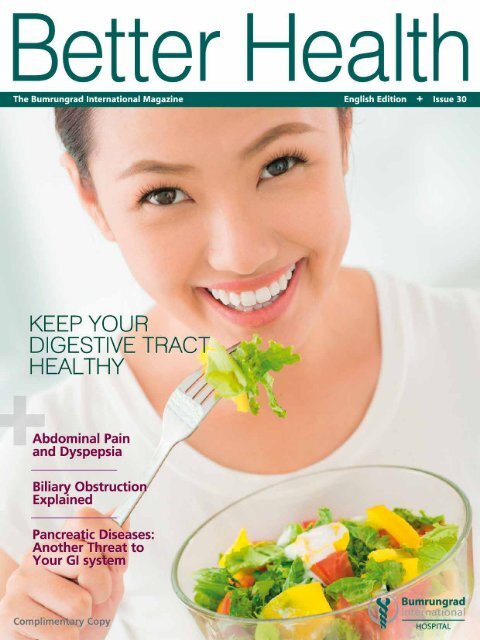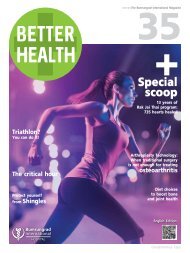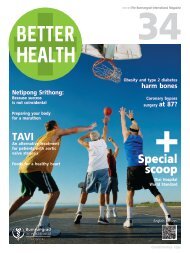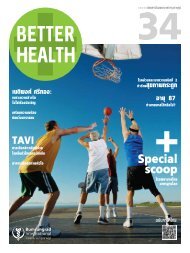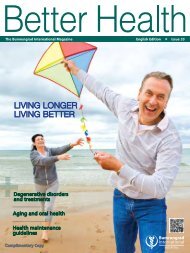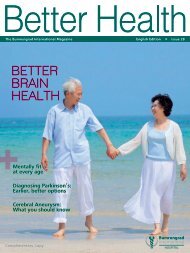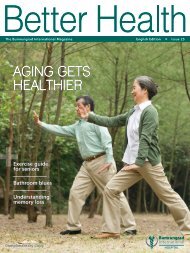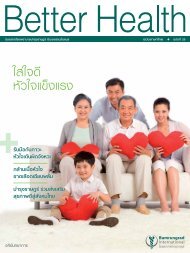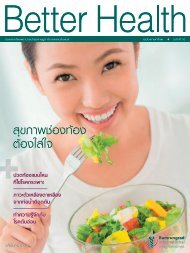Better Health 30 Eng
The magazine for patients and friends of Bumrungrad International Hospital, Thailand.
The magazine for patients and friends of Bumrungrad International Hospital, Thailand.
Create successful ePaper yourself
Turn your PDF publications into a flip-book with our unique Google optimized e-Paper software.
W e l c o m e<br />
Welcome to<br />
, the magazine<br />
for patients and friends of Bumrungrad<br />
International Hospital.<br />
Gastrointestinal (GI) tract diseases can affect<br />
all of us because daily lifestyle habits often cause<br />
them. Routine symptoms like stomachache may<br />
be familiar, and we often think them harmless.<br />
However, abdominal pain can sometimes be<br />
more serious than you think. In this issue of<br />
, we devote special attention to the<br />
story of the stomachache from various causes.<br />
Though many experience diseases related to<br />
gastric disorders, they do not know much about<br />
these specific maladies. On page 6, we move from<br />
the stomach to the intestines with information<br />
about irritable bowel syndrome (IBS). You’ll<br />
learn that a variety of diseases can cause similar<br />
types of abdominal pain in the IBS landscape<br />
that require diverse treatments.<br />
Biliary obstruction is another GI tract disease<br />
that most people do not know much about.<br />
Our article on page 10 explains the causes and<br />
symptoms of this condition. You might be<br />
surprised to learn that consuming half-cooked<br />
food is a cause of biliary obstruction that can<br />
lead to as high as a 90 percent chance of<br />
developing cancer.<br />
Our feature on page 16 concerns some major<br />
health threats such as pancreatic diseases. This<br />
valuable information will increase your awareness<br />
so you don’t miss the opportunity to get the right<br />
and timely treatment.<br />
We welcome your feedback, ideas and<br />
comments about <strong>Better</strong> <strong>Health</strong>. Please e-mail us<br />
at betterhealth@bumrungrad.com.<br />
Here’s wishing you better health.<br />
C o n t e n t s<br />
4 Dyspepsia<br />
Stomach: inside and insights<br />
abdominal pain and dyspepsia<br />
6 Irritable Bowel Syndrome<br />
Get to know and understand IBS<br />
10 Biliary Obstruction Explained<br />
What you need to know about<br />
jaundice and biliary obstruction<br />
14 M.D. Focus<br />
Get to know our doctors<br />
16 Pancreatic Diseases<br />
Pancreatic diseases: another threat<br />
to your GI system<br />
18 Q&A<br />
20 <strong>Health</strong> Briefs<br />
22 News from Bumrungrad International<br />
Dr. Num Tanthuwanit<br />
Chief Executive Officer<br />
Medical Director and Contributing Editor<br />
4 6 20<br />
<strong>Better</strong> <strong>Health</strong> magazine is published by Bumrungrad Hospital Public Company Limited and is produced<br />
for Bumrungrad Hospital Public Company Limited by Oakins and Stone Limited, 10/162 The Trendy<br />
Buiding, 20fl., Room 2001C, Soi Sukhumvit 13 (Saengchan), Khlongtoey - nua, Wattana, Bangkok 10110.<br />
Tel: +66 (0) 2168 7624 Fax: +66 (0) 2168 7625. www.oakinsandstone.com<br />
No part of this magazine may be reproduced without the written permission of Bumrungrad Hospital<br />
Public Company Limited. 2014 by Bumrungrad Hospital Public Company Limited. All rights reserved.<br />
Publication of advertisements or sponsorships shall not constitute an endorsement by Bumrungrad<br />
Hospital Public Company Limited of the products or services promoted, of the company or organization,<br />
nor of the claims made.<br />
Telephone: 66 (0) 2667 1000<br />
Facsimile: 66 (0) 2667 2525<br />
Out-patient<br />
appointment: 66 (0) 2667 1555<br />
Website: www.bumrungrad.com
DYSPEPSIA<br />
Stomach: inside and insights<br />
Abdominal pain and dyspepsia<br />
When someone suffers from abdominal pain, the<br />
term “dyspepsia” usually comes to mind. Indeed,<br />
it seems that most people call stomachaches and<br />
other abdominal conditions dyspepsia.<br />
But is it accurate to say that abdominal pain is dyspepsia?<br />
Moreover, what are the causes of abdominal pain and what<br />
types of pain are signs that you should see your doctor<br />
immediately? You’ll find answers to these questions and<br />
more in this issue of .<br />
Abdominal pain as a warning<br />
Everyone has experienced abdominal pain, but in many<br />
different situations and various forms. The characteristics<br />
of abdominal pain cover a range of characteristics: tightening,<br />
contracting, squeezing, or just mild. These various kinds of<br />
pain are warning signs for a variety of diseases. According<br />
to Dr. Siriwat Arnantapunpong, a physician specializing in<br />
gastroenterology and hepatology, abdominal pain falls into<br />
two broad types based on the area in which it occurs.<br />
Upper abdominal pain: above your navel, usually involves<br />
the stomach, liver, gallbladder, spleen, and pancreas.<br />
Lower abdominal pain: below your navel, usually involves<br />
the large intestine, small intestine,<br />
appendix, kidney, and uterus.<br />
“When a patient complains of<br />
abdominal pain, the first thing the<br />
doctor asks is where it hurts so that<br />
he can narrow down which<br />
organs might cause it,” says<br />
Dr. Siriwat.<br />
“<br />
Gastroscopy is a<br />
favored method<br />
because it’s quick and<br />
effective. The procedure<br />
takes no more than<br />
five minutes.”<br />
Dr. Siriwat Arnantapunpong<br />
“Then the doctor focuses the examination and tests on<br />
those areas to promptly diagnose the cause and begin<br />
treatment as soon as possible.”<br />
Two types of disease cause abdominal pain:<br />
1. Surgical conditions and diseases, such as appendicitis,<br />
leaky gut syndrome, intestinal obstruction, acute peritonitis<br />
or intestinal inflammation, intestinal cancer and gallstones.<br />
Open surgery or endoscopic surgeries are the only ways<br />
to treat these diseases.<br />
2. Internal medical conditions and diseases, such as dyspepsia,<br />
flatulence, excessive stomach gas, chronic constipation,<br />
liver diseases, and intestinal infections.<br />
Which kind of abdominal pain is dyspepsia?<br />
Dyspepsia causes tightening, burning, colic pain around<br />
the middle of the stomach, above the navel or epigastric<br />
region (the upper central area of the abdomen). It can be<br />
both acute and chronic pain.<br />
Acute abdominal pain is severe pain that the patient has<br />
never felt until now. Doctors exercise caution when diagnosing<br />
and treating acute abdominal pain because other diseases,<br />
such as gallstones in the gallbladder or pancreatitis, can<br />
also cause this unbearable level of discomfort.<br />
Chronic abdominal pain is the most common level of pain.<br />
It comes and goes continually for at least a month. This pain<br />
is related to when and what people eat, such as feeling<br />
discomfort from being hungry or too full. This kind of pain<br />
is ordinarily bearable. With proper eating habits or a course<br />
of antacids, the condition should improve.<br />
Dr. Siriwat explains that stomach diseases that cause<br />
chronic abdominal pain include severe gastritis, peptic ulcer<br />
4
or gastric cancer. Among cases of chronic dyspepsia, they<br />
lead to these diseases at a rate of 20 to 25 percent.<br />
The stomach can also suffer from diseases even when<br />
there are no physical anomalies in the organ itself. Rather,<br />
the diseases and pain come from dysfunctions of the<br />
gastrointestinal system. For example, stomach pain can<br />
occur when stomach and intestinal contractions are out of<br />
synchronization, or there is excessive acid in the stomach,<br />
but not enough to be an ulcer. These conditions cause 70 to<br />
75 percent of problems for which patients seek a doctor’s<br />
treatment.<br />
Acid-related stomach conditions, however, do not always<br />
come with abdominal pain. “Many patients come to see<br />
doctors because they vomit blood or have black stools caused<br />
by excessive acid, which causes open wounds and bleeding<br />
in the stomach. Another situation is heartburn caused by<br />
reflux acid in the stomach that inflames esophageal tissue.<br />
In some cases, the inflammation rises up to the throat,<br />
causing coughing fits. All of these symptoms involve the<br />
stomach,” says Dr. Siriwat.<br />
Diagnosis<br />
To find and diagnose chronic abdominal pain, the doctor<br />
reviews the patient’s medical history and performs a regular<br />
physical check-up. The most effective and widely used<br />
method is gastroscopy. With this method, the doctor collects<br />
a tissue sample to find pathological lesions and search for<br />
the helicobacter pylori (H. pylori) bacterium, which causes<br />
many stomach diseases. The doctor can perform these<br />
procedures simultaneously.<br />
“Gastroscopy is a favored method because it’s quick and<br />
effective,” Dr. Siriwat says. “The procedure takes no more<br />
than five minutes. The doctor gives the patient a safe, shortterm<br />
sleeping drug before orally inserting the scope into<br />
the gastrointestinal tract. This method helps the doctor find<br />
the cause swiftly and immediately proceed to treatment.”<br />
Besides gastroscopy, the doctor may include a CT scan<br />
and ultrasound in the diagnosis especially if the patient has<br />
an acute condition. In addition to gastroscopy, other methods<br />
used to find H. pylori are a blood test or breath test, in which<br />
the patient simply has to exhale into a device.<br />
Drugs don’t help?<br />
Suspect H. pylori<br />
H<br />
elicobacter pylori is the main cause of<br />
chronic gastritis, peptic ulcer, gastric ulcer,<br />
stomach cancer and gastric lymphoma. Data show<br />
that there are over 2 billion people currently<br />
infected with these bacteria worldwide.<br />
In Thailand, about 40 percent of dyspepsia<br />
patients are infected with this bacterium. Cases<br />
occur mostly in the northern and northeastern<br />
region where food often hasn’t been cooked well<br />
enough before consumption.<br />
Treatment and prevention<br />
For patients with peptic ulcer and gastritis, which are<br />
not caused by H. pylori, doctors prescribe antacids to<br />
decrease acid in the stomach and help the wound to heal<br />
faster. Doctors may also use medicines that protect stomach<br />
tissue. H. pylori ailments can be completely cured with a<br />
two-week course of antibiotics.<br />
For stomach dysfunction-related dyspepsia doctors<br />
sometimes prescribe a drug called prokinetic. Prokinetic<br />
supports stomach and intestine movement and helps the<br />
stomach and esophagus function better together.<br />
Dyspepsia is not a severe disease. But if the patient neglects<br />
it many complications can follow such as stomach bleeding,<br />
perforation, and stomach obstruction, some of which can<br />
be fatal.<br />
Therefore, Dr. Siriwat advises that people should only eat<br />
food that is well cooked, clean, not too spicy, and consumed<br />
in moderate amounts. Stress control, alcohol and coffee<br />
abstinence, and caution in taking drugs that disturb the<br />
stomach are important factors in preventing dyspepsia.<br />
Follow this routine and your stomach will not suffer from<br />
dyspepsia.<br />
No dawdling for these pains<br />
I<br />
f you suffer come-and-go abdominal pain for four weeks or more,<br />
see your doctor. But if these conditions accompany the pain seek<br />
medical attention immediately:<br />
Abdominal pain with vomiting<br />
Changing abdominal pain such as burning pain turning into squeezing<br />
pain, contracting pain or the pain becomes harsher<br />
Anemia, possibly from losing blood through stomach wounds<br />
Yellow eyes<br />
Chronic fever that stays at around 37.5 – 38 degrees<br />
Weight loss of over 10 percent within 1 to 2 months<br />
Taking antacids for 1 to 2 weeks but showing no sign of<br />
improvement or suffering from other complications<br />
5
IRRITABLE BOWEL SYNDROME<br />
Not that Serious but Chronic<br />
Get to Know and<br />
Understand IBS<br />
The symptoms of chronic abdominal<br />
pain, constipation, and diarrhea that<br />
do not respond sufficiently to medical<br />
treatment affect many people.<br />
What can people do if they have<br />
this condition, known as Irritable Bowel<br />
Syndrome?<br />
Irritable Bowel Syndrome (IBS) is a disease frequently<br />
diagnosed as the culprit of many patients’ digestive<br />
problems. But, not surprisingly, these patients often<br />
misunderstand its symptoms, which are similar to other<br />
diseases, such as various stomach disorders, constipation<br />
and diarrhea.<br />
talks with Dr. Suriya Chakkapak, a surgeon<br />
who specializes in Gastroenterology and Hepatology, to<br />
help you better understand the Irritable Bowel Syndrome<br />
group of ailments.<br />
What is Irritable Bowel Syndrome?<br />
IBS is a group of symptoms occurring from bowel<br />
dysfunction, but in which no physical bowel disorder (tumor,<br />
cancer, inflammation, or other conditions, etc.) could be<br />
identified as the cause, Dr. Suriya explains.<br />
IBS patients’ main symptom is chronic stomachache and<br />
abdominal pain, on and off for a period of over six months,<br />
in conjunction with bowel habit disorders.<br />
<br />
“ Most IBS patients visit a doctor<br />
presenting stomach pain and<br />
abdominal discomfort—<br />
particularly pain in the lower<br />
abdomen, either on the left<br />
or right side—along with<br />
constipation or diarrhea<br />
symptoms,”<br />
Dr. Suriya Chakkapak<br />
IBS symptoms categories:<br />
Diarrhea Group;<br />
Constipation Group;<br />
Diarrhea Group alternating with Constipation Group;<br />
Mixed type alternating with occasional complication<br />
and diarrhea<br />
“Most IBS patients present with abdominal discomfort –<br />
particularly pain in the lower abdomen, either on the left or<br />
right side – along with constipation or diarrhea symptoms,”<br />
Dr. Suriya says. “In some cases the patient has loose stools<br />
or diarrhea continuously for many days, which adds to his<br />
or her discomfort and anxiety. But a patient with IBS-related<br />
constipation or bound belly experiences symptoms differently<br />
than from general digestive problems. For example, a patient<br />
with a general disorder will have abdominal pain or discomfort<br />
simultaneously. However, after defecation, abdominal<br />
pain or discomfort symptoms diminish.”<br />
Patients with IBS symptoms have no other key indicators<br />
of a dangerous condition, such as fecal<br />
mucus or bloody stools, weight loss,<br />
vomiting, decreasing size of stools or<br />
rectal tenesmus (a feeling of constantly<br />
needing to pass stools).<br />
Causes and Diagnosis<br />
Although IBS is the most frequently<br />
diagnosed bowel disease, the medical<br />
community has still not been able to<br />
identify its cause definitively. Doctors’<br />
best estimate is that some unknown<br />
mechanism causes nerve sensitivity in<br />
gastrointestinal motility (the movement<br />
of food through the digestive system) in<br />
the alimentary canal.<br />
Despite not knowing the root cause,<br />
physicians now understand more about
IBS’s characteristics and effects so can better diagnosis it.<br />
“To diagnose, we start with blood and stool tests, the patient’s<br />
medical history and whether family members have colon<br />
cancer or gastrointestinal cancer,” Dr. Suriya says. “These<br />
procedures enable us to separate and classify symptoms<br />
to be sure that the patient has IBS.”<br />
Regarding using endoscopy (a tubular camera device<br />
that looks inside the digestive tract) to diagnose, Dr. Suriya<br />
says it’s not necessary if the patient has no obvious risk<br />
factors for more serious conditions. Risk factors that do<br />
indicate performing a colonoscopy include the patient being<br />
over 40 years old, which raises the risk for colon cancer,<br />
or a history of constipation for long periods.<br />
After these various examination procedures rule out a<br />
serious physical disorder, a doctor can then diagnose the<br />
patient with IBS.<br />
Symptomatic Treatment<br />
Since IBS has no clear cause, the attending doctor focuses<br />
on treating the patient’s symptoms, such as prescribing<br />
laxatives, medicines that relieve abdominal cramps, antacids<br />
and antidiarrheal regimens. Keep in mind, however, that<br />
these treatments do not eliminate the underlying cause<br />
eating fat-rich foods, then you should avoid them. Also, to<br />
prevent gastrointestinal tract infections and their symptoms,<br />
avoid unclean food and water.”<br />
of IBS. Therefore, the patient may have to endure these<br />
symptoms repeatedly.<br />
Dr. Suriya suggests that since IBS’s cause is unknown,<br />
patients should avoid risky behaviors that may lead to<br />
functional bowel disorder, such as:<br />
Unhealthy eating habits, including irregular eating patterns<br />
(for example, skipping breakfast), taking high-fat and<br />
fast foods, or foods with little or no fiber.<br />
Habits or activities that cause continual stress and anxiety<br />
Allowing abdominal pain to go untreated to the point<br />
where it becomes a chronic symptom<br />
“Patients must be attentive to their condition and avoid<br />
behaviors that cause and aggravate IBS symptoms,” advises<br />
Dr. Suriya. “For example, if you have stomach pain after<br />
Change Your Behaviors; It Helps<br />
Irritable Bowel Syndrome is not a life-threatening disease<br />
nor is it a signal of cancer. Patients with IBS can enjoy<br />
long lives, but enduring these on-and-off aliments results<br />
in poorer quality of life. Because the symptoms cannot<br />
be completely cured, most IBS sufferers are in a state of<br />
ongoing stress worrying that they have a more serious<br />
disease. In practical terms, for example, IBS-related diarrhea<br />
interferes with patient’s daily lives because they have to go<br />
to the restroom so often.<br />
“The best method to cope with IBS is to not think that<br />
it’s a dangerous disease,” Dr. Suriya says. “The more stress<br />
you have, the worse the symptoms get. Along with treatments<br />
doctors prescribe to relieve symptoms patients should adjust<br />
their behaviors in order to lessen symptoms and reduce<br />
the frequency of IBS-related events,” Dr. Suriya concludes.<br />
Irritable Bowel Syndrome requires time to cure. Knowing<br />
and understanding this disease helps people have a better<br />
quality of life.
BILIARY OBSTRUCTION<br />
What you need to know about<br />
jaundice and biliary obstruction<br />
While jaundice may sound familiar to most people,<br />
one of its possible causes — biliary obstruction —<br />
should not be ignored.<br />
Jaundice’s familiar symptoms – yellow-tinted eyes, skin <br />
and urine – can be caused by a myriad of factors. <br />
Besides hepatitis and liver diseases, biliary obstruction<br />
is another possible cause. To better understand the condition<br />
talks to board-certified gastroenterologist <br />
and hepathologist Dr. Yudhtana Sattawatthamrong who <br />
has more than 20 years experience in this field.<br />
<br />
How the bile system works<br />
“The bile duct system, which is part of the digestive <br />
system, can be compared to branches of a tree,” explains <br />
Dr. Yudhana. “Bile is a dark green or yellow-brown liquid <br />
secreted by the liver. It passes through tiny tubes called <br />
bile ducts connected to the gallbladder where it is stored <br />
and becomes concentrated and intensified. When you eat, <br />
food is transported to the stomach and the intestine, <br />
which triggers secretion of a hormone to stimulate the <br />
gallbladder to release bile into the small intestine (the <br />
duodenum) to facilitate fat digestion and absorption.”<br />
<br />
Causes of blockages<br />
Bile duct blockage is usually caused by two conditions: <br />
stones and tumors. “Bile duct obstruction caused by <br />
stones can be found anywhere in the bile duct system,” <br />
says Dr. Yudhana. “Gallstones occur when bile, which is <br />
normally fluid, forms stones. Gallstones commonly are <br />
lumps of fatty, cholesterol-like material that has solidified <br />
and hardened. Additionally, bile pigments or calcium <br />
deposits can also form gallstones.”<br />
Gallstones become more common with increasing age <br />
after 40. The risk of forming gallstones also increases<br />
with pregnancy, obesity, diabetes, liver cirrhosis, and<br />
thalassemia. Women with abnormal hormone levels or <br />
who use contraceptive pills have increased risk of forming <br />
gallstones.<br />
“When bile ducts become blocked, bile builds up in the <br />
liver and spreads into the blood stream. Jaundice develops <br />
due to increasing levels of a blood component called <br />
bilirubin, which could lead to life-threatening infections,” <br />
Dr. Yudhana continues.<br />
Patients with obstructed bile ducts caused by stones <br />
and tumors can have differing symptoms. “Patients with <br />
biliary obstruction caused by stones may experience <br />
jaundice accompanied by upper abdominal pain that <br />
radiates to the back, fever, shivering cold, and infection,” <br />
says Dr. Yudhana. “Patients who have blocked bile ducts <br />
caused by tumors will experience jaundice, but not abdominal<br />
Bile duct location diagram<br />
gallbladder<br />
bile duct<br />
small intestine<br />
stomach<br />
pancreas and<br />
pancreatic duct<br />
10
pain since tumors gradually develop and grow.<br />
The bile ducts are increasingly blocked over <br />
time, causing them to swell.”<br />
Ninety percent of biliary obstruction caused <br />
by tumors can further develop into cancer. In <br />
Thailand, bile duct cancer is common in the <br />
northeastern region where people consume <br />
uncooked or undercooked freshwater fish <br />
containing parasites. When the parasites enter<br />
the bile duct, their waste products can cause <br />
bile duct cells to develop uncontrollably which <br />
can develop into cancer.<br />
<br />
Diagnosis and treatment<br />
To diagnose biliary obstruction doctors <br />
check the patient’s health history and perform <br />
a blood test to confirm the cause of the <br />
jaundice. An ultrasound test is also prescribed <br />
to examine the bile duct blockages. “Doctors <br />
examine the biliary tree thoroughly, including <br />
intrahepatic bile ducts, the common hepatic <br />
bile duct, and the pancreatic duct. In most <br />
cases ultrasound images are sufficient for<br />
doctors to diagnose and plan treatment. In cases where<br />
an ultrasound is not definitive, we recommend a<br />
CT scan, MRI, MRCP, or an Endoscopic Retrograde<br />
Cholangiopancreatography (ERCP),” says Dr. Yudhana.<br />
Bile duct blockages can be life threatening if left <br />
untreated. “In the past, treating biliary obstruction caused <br />
“ The risk of forming <br />
gallstones increases<br />
with thalassemia,<br />
women with abnormal <br />
hormone levels, <br />
pregnancy, obesity,<br />
diabetes, liver cirrhosis, <br />
and age over 40.”<br />
Dr. Yudhtana Sattawatthamrong<br />
by gallstones required open surgery,” Dr. Yudhana points <br />
out. “A six-inch abdominal incision was made to remove <br />
stones in the bile duct. Nowadays, the surgery is done<br />
using ERCP, which allows doctors to diagnose and treat<br />
biliary blockage by bile duct stones simultaneously. This<br />
procedure doesn’t require any incision in the abdomen<br />
and promotes faster recovery.” <br />
In an ERCP procedure, a flexible tube with a micro-<br />
camera is inserted in the mouth and gently guided down <br />
the throat into the esophagus, stomach, and duodenum <br />
until it reaches the point where ducts from the pancreas <br />
and gallbladder drain into the duodenum. If a bile duct<br />
stone is present, the doctor can sometimes remove it<br />
by dragging it into the small intestine so the body can<br />
eliminate it during bowel movement.<br />
“To treat bile duct blockage caused by tumor the doctor <br />
needs to obtain a tissue sample for further testing to <br />
confirm if the tumor is malignant, which can also be done <br />
during an ERCP session,” Dr. Yudhana says. “If the tumor <br />
is cancerous the doctor will plan additional treatment.<br />
An important point to consider is if the patient also has <br />
jaundice caused by bile duct blockage. Treating this requires<br />
inserting a stent or undergoing surgery to bypass the bile <br />
duct blockage and drain the bile fluid into the intestine <br />
before treating the cancer.”<br />
While diagnoses of biliary blockage can be done quite <br />
easily, spotting the first-stage warning signs or taking <br />
preventive approaches still remain challenging. However, <br />
taking control of your health by eating healthy and doing <br />
regular exercise are very helpful in preventing these <br />
conditions.<br />
12
Get to know our doctors<br />
Meet four Bumrungrad physicians who share their thoughts on a range<br />
of healthcare topics.<br />
Providing the highest standards of patient care requires a hospital-wide commitment and professional expertise.<br />
Bumrungrad’s medical staff includes over 1,<strong>30</strong>0 world-class doctors of the highest caliber, with outstanding<br />
professional credentials and advanced training across the full spectrum of medical sub-specialties.<br />
Dr. Navara Dusitanond Surgeon - General Surgery, Colorectal Surgery<br />
Dr. Nawara graduated (with second-class honors) in the field of general surgery<br />
and as a colorectal specialist from the Surgery Department, Chulalongkorn<br />
University. Before joining the Bumrungrad team, he worked with the Naval<br />
Medical Department, the King Chulalongkorn Memorial Hospital, the Thai Red<br />
Cross Society, and the Chulabhorn Research Institute.<br />
Q: What are your<br />
impressions of working<br />
at Bumrungrad?<br />
A: Bumrungrad is<br />
highly professional in<br />
management, treatment technology and personnel. Each<br />
unit takes responsibility for its duties, which makes taking<br />
care of patients efficient and up to standard. Both the medical<br />
community and patients regard Bumrungrad as one of the<br />
most capable and successful hospitals in the country. For<br />
doctors, working here is quite challenging because we often<br />
take on difficult cases from both domestic and international<br />
patients. In some cases, I’m presented with situations I’ve<br />
never seen.<br />
Q: How do you handle stress?<br />
A: I have many hobbies such as photography and traveling.<br />
But what I like the most is scuba diving because I get to live<br />
with nature to the fullest extent for a full three to four days<br />
on a boat in the middle of the sea. With no phone signal, I am<br />
completely cut off from the outside world. For me, this is the<br />
best way to deal with stress.<br />
Dr. Sudarat Yaisawang Ophthalmologist - Ophthalmology (Eye), Pediatric Ophthalmology<br />
Along with Dr. Sudarat’s practice, which specializes in pediatric ophthalmology<br />
and squinting, she is highly regarded as the president of the Royal College of<br />
Ophthalmologists of Thailand and head of the Ophthalmology Department,<br />
Chulalongkorn University. She held various administrative and academic<br />
positions before coming out of retirement to join the medical staff at<br />
Bumrungrad International.<br />
Q: What are common child vision problems?<br />
A: Because children today spend so much time staring at<br />
computer screens they suffer from nearsightedness at a young<br />
age, which increases more rapidly than in the past. Parents<br />
must warn their children to rest their eyes frequently by<br />
looking into the distance. They should also encourage them<br />
to engage in outdoor activities.<br />
Q: Which cases are most memorable?<br />
A: Although I’m a pediatric ophthalmologist, I treat patients<br />
of all ages. I have several elderly patients who have been<br />
coming to me for so long they seem like close relatives. Some<br />
moved on to other doctors, but they missed me so much<br />
that they have come back to my practice. These longtime,<br />
loyal patients truly<br />
impress me.<br />
Q: What gives you<br />
pride in your work?<br />
A: In 1982, there was turmoil in Cambodia. Thailand gave<br />
support to up to 100,000 refugees at Khao-I-Dang refugee<br />
camp, which lacked sufficient medical personnel. Seeing<br />
this need, I volunteered to be the chief of the Thai Red Cross<br />
Eye Specialist Surgical Team to treat these refugees. I<br />
commuted between the camp and Bangkok every weekend<br />
for more than 10 years. The American Red Cross recognized<br />
my service with a humanitarian award, which made me feel<br />
honored and proud.<br />
14
Dr. Koonlawee Nademanee Cardiology - Arrhythmia Center<br />
For more than <strong>30</strong> years, Dr. Koonlawee has taken care of patients with physiological<br />
cardiac problems and cardiac arrhythmia in Thailand and the US. Along with his<br />
practice, he conducts research continuously to develop and improve treatment.<br />
The medical community holds Dr. Koonlawee in high regard as one of the country’s<br />
finest doctors and dedicated researchers.<br />
Q: What is the most difficult aspect of your work<br />
as a doctor?<br />
A: As a doctor, giving my best to treat patients is all I<br />
want, but to have all patients fully recover is impossible.<br />
Therefore, the more patients I treat, the odds of incurable<br />
cases increase. Even though the number of incurable<br />
patients is small, I think about them, as it’s hard to<br />
restrain my mind. For example, if I treat 100 patients<br />
and can’t cure two percent, this means there are two<br />
incompletely cured people out of 100. But if I treat 1,000<br />
patients the number of incurable cases also rises.<br />
Q: What principles guide your work?<br />
A: Keep learning, always. I strive to remind myself<br />
every day that I have yet to know all that I should.<br />
Accordingly, I constantly<br />
seek additional knowledge<br />
and new technologies and<br />
then adapt them to research<br />
work to acquire the best<br />
benefits in treating patients.<br />
Q: How has treatment<br />
technology changed in recent decades?<br />
A: Medical technology changes dramatically and quickly.<br />
This acceleration occurs not only because doctors are<br />
more competent, but also because many fields of knowledge<br />
have advanced so much, such as software development<br />
and engineering. Additionally innovations, such as<br />
ultrasound, MRI, and CT scans greatly improve and<br />
advance treatment technology.<br />
Dr. Nattawut Wanumkang Ophthalmologist - Ophthalmology, Oculoplastic & Reconstructive Surgery, Cataract<br />
Dr. Nattawut graduated as a specialist from the University of California, San<br />
Diego. He specializes in dacryocystitis, diseases of the eyelids and eye sockets,<br />
and eyelid plastic surgery. He also devotes time to educating colleagues in<br />
new ophthalmological knowledge domestically and internationally.<br />
Q: What sparked your<br />
interest in academics?<br />
A: Giving full involvement<br />
in my specialty is what<br />
underlies my passion for<br />
ongoing study. Intensive<br />
practice and experience prepare us to treat actual medical<br />
problems and train us to always look for better solutions.<br />
I believe we should never stop revisiting and revising our<br />
knowledge. And once we’re confident in our knowledge<br />
and abilities, we must share it through our practice. The<br />
more we give, the more we receive. When we share<br />
knowledge with others, whether they use the knowledge<br />
in their practices or pass it on, this brings me much<br />
happiness.<br />
Academic work is about giving. I think hospitals<br />
prepared with equipment and personnel that can handle<br />
enough cases, can develop into specialized medical centers<br />
for knowledge transfer. We accomplished this goal at<br />
Mettapracharak Watraikhing Hospital. When I joined<br />
Bumrungrad International, I saw great potential to do the<br />
same thing here. Recently, we’ve established seminars<br />
and workshops on Master Techniques in Ophthalmic<br />
Plastic and Reconstructive Surgery, the second International<br />
Training Course with international world-class specialists<br />
who came to Thailand to give lectures. They passed on<br />
their vital knowledge to more than 250 doctors, which I<br />
consider a very successful result.<br />
Q: What are your impressions about working<br />
at Bumrungrad?<br />
A: Bumrungrad has many board-specialized doctors<br />
with impressive expertise. I recall a very difficult case<br />
where a patient had cancer on the upper part of the face.<br />
The cancer went through the eye socket into the brain.<br />
We mobilized doctors from all related fields to participate<br />
in the treatment. The surgery took 11 hours to accomplish.<br />
The collegial work environment barely differed from that<br />
of medical school. Such a cooperative scenario is quite<br />
hard to find.<br />
15
PANCREATIC DISEASES<br />
Pancreatic diseases<br />
Another threat to your GI system<br />
P<br />
ancreatitis, pancreatic cancer and pancreatic cysts<br />
may be rare diseases compared to other ailments<br />
in the gastrointestinal system, but these illnesses<br />
can be deadly while showing no noticeable symptoms.<br />
For those who possess risk factors, being informed about<br />
pancreatic diseases and their specific conditions raises<br />
awareness and promotes a patient’s prompt action to engage<br />
specialists for treatment, increasing the odds of survival.<br />
The sooner these diseases get diagnosed, the better the<br />
chances for a cure.<br />
This issue of<br />
has information about pancreatic<br />
diseases from Dr. Rujapong Sukhabote, a physician specializing<br />
in gastroenterology and hepatology.<br />
The pancreas, an introduction<br />
The pancreas is an organ in the gastrointestinal track.<br />
It is a sizable gland, shaped like an elliptical leaf around<br />
10 cm long. The pancreas is not positioned in the abdominal<br />
cavity, but rather is located behind the stomach, close to the<br />
upper part of the small intestine.<br />
The pancreas is composed of two kinds of cells. Endocrine<br />
gland cells produce various hormones including insulin and<br />
glucagon, which control blood sugar levels. Exocrine gland<br />
cells produce juice for digesting food, especially fat. This juice<br />
is delivered to the small intestine through the pancreas.<br />
gallbladder<br />
Pancreas location diagram<br />
bile duct<br />
pancreas<br />
pancreatic duct<br />
Pancreatitis<br />
Pancreatitis is the most common pancreatic disease.<br />
Dr. Rujapong explains that pancreatitis is a condition in<br />
which pancreatic juice cannot flow through the pancreatic<br />
duct, resulting in the self-digesting of pancreatic tissue<br />
and consequently inflammation. Serial incidents of these<br />
inflammations will turn into a chronic condition and cause<br />
calcification in the pancreas. The pancreas will then reduce<br />
in size, limiting its efficiency.<br />
“Pancreatitis comprises two types: acute and chronic,”<br />
says Dr. Rujapong. “The disease starts with acute inflammation.<br />
If the ailment is not properly treated, or is treated, but the<br />
condition reoccurs because the cause is not dealt with, the<br />
inflammation becomes chronic.”<br />
Acute pancreatitis patients suffer from non-stop, intense<br />
pain. “The searing pain feels as if the patient were being<br />
stabbed with a knife,” the doctor notes. “Nausea or vomiting<br />
are also symptoms. In rare cases patients only have minor<br />
abdominal discomfort or no pain at all.”<br />
For chronic pancreatitis, the abdominal pain may be<br />
lessened, but it is accompanied by other complicated<br />
conditions such as chronic stomachache, uncontrollable<br />
sugar levels, diabetes, chronic diarrhea due to undigested<br />
fat, fat-filled feces, weight loss and jaundice.<br />
small intestine<br />
duodenum<br />
Causes of pancreatitis<br />
Heavy alcohol consumption and gallstones in the gallbladder<br />
are the most common causes of pancreatitis. Other causes<br />
are high triglyceride levels, side effects from some drugs,<br />
16
autoimmune diseases, parasites or viruses. “There<br />
is about a 5 to 10 percent chance that the cause<br />
can’t be determined. These patients will time and<br />
again suffer from the disease because we don’t<br />
know what to treat,” says Dr. Rujapong.<br />
Diagnosis and treatment<br />
A patient with acute pancreatitis will probably<br />
see a doctor because of symptoms that include<br />
stomachache, nausea, vomiting, or fever. The doctor<br />
will then perform tests to confirm that the ailment<br />
is pancreatitis. A blood test reveals which of the<br />
pancreas’s enzymes are heightened and ultrasound<br />
and CT scans show if the pancreas is inflamed.<br />
For a patient diagnosed with pancreatitis the<br />
doctor prescribes analgesics and then forbids the<br />
patient from drinking any water or consuming<br />
food for a certain time to stop the pancreas’s<br />
functioning. (The patient will be provided with<br />
enough water for 24 to 48 hours to prevent dehydration.) In<br />
cases of severe pancreatitis where the pancreatic tissue is<br />
in decay, there is a high chance for infection. The doctor will<br />
prescribe antibiotics or perform surgery to directly cleanse<br />
the pancreas.<br />
“Acute pancreatitis can be permanently cured if the cause<br />
is identified,” says Dr. Rujapong. “For example, if there are<br />
gallstones in the gallbladder, removing the gallstones will<br />
resolve the problem. That’s why — unless it is found too<br />
late or with complications — acute pancreatitis has a low<br />
fatality rate. For patients with chronic pancreatitis with an<br />
unknown cause, they need to follow their doctors’ instructions<br />
closely since the disease can lead to other debilitating conditions<br />
such as diabetes or pancreatic cancer.”<br />
Pancreatic cancer<br />
Though rarely found in Thailand, patients with pancreatic<br />
cancer are increasing in number. According to World <strong>Health</strong><br />
Organization reports, pancreatic cancer ranks seventh<br />
worldwide and fourth in the USA as the cause of cancer<br />
deaths.<br />
Causes and symptoms<br />
Pancreatic cancer is classed as a severe condition because<br />
diagnosis is difficult and there are no definite symptoms in<br />
the early stage. The patient may complain to his or her doctor<br />
“<br />
Acute pancreatitis has<br />
a low fatality rate because<br />
it can be permanently<br />
cured if the cause is<br />
identified with no<br />
complications.”<br />
Dr. Rujapong Sukhabote<br />
about stomachache, flatulence, loss of appetite or jaundice.<br />
However, in many cases, there are no visible symptoms.<br />
Many times the condition is discovered through a routine<br />
physical check-up. In this instance the doctor notices anomalies<br />
in blood tests and develops a further diagnosis by using<br />
a CT scan.<br />
The cause of this disease is yet to be identified, but those<br />
who smoke, eat meat with high fat content and have a genetic<br />
predisposition are at risk of developing pancreatic cancer.<br />
Additionally, those who suffer from chronic pancreatitis and<br />
pancreatic cysts are also at risk.<br />
Treatment<br />
Surgery to remove the cancer is always the best treatment<br />
as long as the tumor is found quickly and has not yet spread<br />
to other parts of the body. “There are many cases that are<br />
found too late,” Dr. Rujapong warns. “Patients either have<br />
conditions too critical to undergo the operation or have really<br />
low survival rates. That’s why we always advise those who<br />
are at risk to get regular physical check-ups, once every six<br />
months to a year.”<br />
This disease does not always come with obvious symptoms<br />
or a cure. If you are seemingly healthy, but at risk for any<br />
diseases, don’t take it for granted. When it comes to your<br />
health you can’t let your guard down.<br />
Pancreatic cysts<br />
C<br />
ysts are a condition that can occur on any organs or tissue,<br />
including the pancreas. A cyst is a sack containing water or<br />
some other bodily liquid. Sometimes it can contain soft ,<br />
which is a mix of liquid and tissue.<br />
Pancreatic cysts are a rare condition. Many times they are so small<br />
they cause no discernable symptoms. These tiny cysts can be found<br />
using ultrasound or CT scans. If the liquid inside does not show any<br />
abnormality in the test, the doctor will take no action other than to<br />
continue to observe if they get bigger. But if the doctor suspects that<br />
they have a risk of developing into cancer then he or she will immediately<br />
suggest surgery to remove them.<br />
Pancreatic cysts can happen to anyone no matter the patient’s age<br />
or gender. Finding this disease is just one advantage of having regular<br />
physical check-ups.<br />
17
D<br />
igestive health problems are found in people<br />
of all ages and in some circumstances are hard<br />
to treat. Accurate advice from experts can help<br />
you deal with the problems properly while also reducing<br />
anxiety.<br />
Q: My daughter has diarrhea. Is it true that I should feed<br />
her yogurt instead of medications?<br />
A: Normally, doctors recommend that you avoid dairy<br />
products when having diarrhea. But fermented milk or<br />
yogurt is the exception, despite that it comes from milk.<br />
This is because yogurt has live or active cultures called<br />
Probiotics such as Lactobacillus and Bifidobacterium. When<br />
eaten in adequate amounts these organisms appear to help<br />
establish a healthier balance of bacteria in the digestive<br />
tract. These live cultures help restore the good bacteria in<br />
your intestine and reduce stomachache or diarrhea caused<br />
by bad bacteria.<br />
However, only eating yogurt is not enough. First and<br />
foremost you should prevent dehydration and a keep a good<br />
balance of liquids and minerals in the body by drinking<br />
water or sport drinks. It is not always necessary to take<br />
medication. Excretion is the body’s natural way to expel<br />
germs and waste. Certain drugs that stop excretion may<br />
result in the body storing germs and cause harmful effects<br />
including slowing down the recovery process.<br />
Q: I tend to get traveler’s diarrhea and am quite<br />
worried about it. Should I preventatively take medicines<br />
before traveling?<br />
A: Anywhere from 20 percent to 50 percent of<br />
international travelers may suffer from the nightmare<br />
of traveler’s diarrhea at some stage during their travels.<br />
The onset of and recovery from traveler’s diarrhea usually<br />
occurs within a week of travel. Therefore, doctors generally<br />
do not recommend taking anti-diarrhea medicine because<br />
it may cause side effects such as flatulence. Normally, the<br />
primary source of infection is ingestion of fecal-contaminated<br />
food or water. Thus, travelers should pay careful attention<br />
to the food and water that they ingest, avoiding<br />
half-cooked, unusual and unclean food items.<br />
Q: I just turned 50 and my doctor has recommended a<br />
colonoscopy for colon cancer screening. Will it hurt? Are<br />
there alternatives to<br />
colonoscopy that are<br />
equally effective?<br />
A: The latest<br />
incidence statistics<br />
from the National<br />
Cancer Institute<br />
claim that among<br />
new cancer patients,<br />
colon and rectal cancer<br />
is second only to breast<br />
cancer. The incidence<br />
rates increase in people aged 50 and over and is more common<br />
among males than females. If you are at risk, you should<br />
consult a doctor or genetic counselor to get screened and<br />
analyze your risk of developing cancer.<br />
Nowadays, there are several methods to screen for colorectal<br />
cancer. Apart from a colonoscopy, the cancer can also be<br />
detected with a fecal occult blood test, sigmoidoscopy and<br />
computerized x-ray. Each method has pros and cons. Specialists<br />
choose the most suitable method for each patient. But<br />
generally, colonoscopy is a safe and highly precise way to<br />
detect colon and rectal cancer. Besides, before starting the<br />
test, patients are given a sedative so that they avoid the<br />
test’s discomfort.<br />
18<br />
Have a question? You can submit your question for possible inclusion in future issues of , by e-mail<br />
betterhealth@bumrungrad.com or by mail to Editor, Magazine, Bumrungrad International Hospital,<br />
33 Sukhumvit 3, Wattana, Bangkok 10110, Thailand.
HEALTH BRIEFS<br />
Alcohol with tobacco, a cocktail<br />
for esophageal cancer<br />
It’s a fact that alcohol and tobacco play important <br />
roles in developing esophageal cancer, but a recent <br />
study published in The American Journal of Gastronomy<br />
found that the combination of both doubles the risk <br />
compared to those who either smoke or drink.<br />
Researchers from the University of Michigan, <br />
United States, have assembled data from various <br />
databases including many studies concerning patients<br />
with esophageal cancer and how tobacco and alcohol <br />
affect their conditions.<br />
After systematic review, <br />
they confirmed that<br />
smoking and drinking<br />
are both independent <br />
and dependent risk <br />
factors for esophageal <br />
cancer.<br />
Survival rate of bowel cancer <br />
increases with vitamin D<br />
Arecent study from the University<br />
Edinburgh, United<br />
finds that patients with bowel <br />
cancer supplied with enough <br />
vitamin D have distinctly <br />
higher chances of <br />
surviving the disease, <br />
especially those in stage <br />
2, at which point the <br />
tumor may be quite <br />
large but the cancer has <br />
not yet spread.<br />
Researchers tested <br />
blood samples from almost <br />
1,600 patients after surgery <br />
for bowel cancer and found that <br />
three quarters of patients with high <br />
vitamin D levels are still alive after five years while those <br />
with low vitamin D survive at a rate of less than two thirds.<br />
This has evidently proved that vitamin D helps increase <br />
the survival rate, though the nature of the relation still <br />
remains unclear.<br />
However, the study also says that the research only <br />
observes natural vitamin D intakes such as from sunlight <br />
or food. Further study is still needed to know whether <br />
vitamin D supplements yield the same effect.<br />
Training toddlers to eat<br />
veggies should begin<br />
before the age of two<br />
“M<br />
y child does not eat vegetables.” This is a cause for <br />
concern for parents in many households worldwide.<br />
No matter how many tricks parents have up their sleeves, <br />
they find it difficult to get their children to say yes to those <br />
green leaves. Many have given up on trying, but a recent <br />
study by a cooperative effort at universities in <strong>Eng</strong>land, <br />
France and Denmark has found the latest trick for parents<br />
to try: have your children eat vegetables as early and as <br />
continually as possible.<br />
The study had 403 preschool children, aged 4 months to <br />
3 years, eat 100 to 200 grams of artichoke puree 5 to 10 <br />
times by serving it as meals or afternoon snacks and<br />
observed how much each child ate. The result is 40 percent<br />
of all children were likely to eat more vegetables each time, <br />
21 percent consumed most of what was offered every time, <br />
16 percent still refused the food even after five attempts <br />
and the rest are those whose patterns were too variable<br />
to specify.<br />
“Younger children are less picky about their food,”<br />
a researcher involved in the study says. “We found <br />
that training children to eat vegetables should begin <br />
before the age of two. You also need to be consistent <br />
and the result should show after 5 to 10 times.”<br />
20
Bumrungrad International hosts the<br />
Asian Full-Endoscopic Workshop<br />
B<br />
umrungrad Spine Institute, led by Dr. Verapan Kuansongtham<br />
(fourth from left) and Dr. Sompoch Paiboonsirijit (fourth<br />
from right), together with St. Anna Hospital Germany, recently<br />
hosted the Live Surgery and Lecture of Full-Endoscopic<br />
Operations of the Lumbar, Thoracic and Cervical Spine. An<br />
international roster of surgeons attended, including several<br />
from Thailand. The workshop will be conducted once in Thailand<br />
and twice in Germany each year. This was the fifth of such<br />
workshops held in Thailand.<br />
Bumrungrad announces<br />
‘Simulation Training Center’<br />
M<br />
r. Dennis Brown (first from left), Bumrungrad’s Corporate<br />
CEO, Dr. Jitra Anuras (second from left), acting Medical<br />
Director, together with hospital executives recently announced<br />
the launch of a unique Simulation Training Center.<br />
Bumrungrad is Thailand’s first private hospital to use such an<br />
innovative training facility to improve patient care. The Simulation<br />
Training Center is currently equipped with the latest full-body<br />
manikin and infant manikin, which can simulate more than 60 key<br />
situations including pulse, heart rate, pulmonary sound, sweating,<br />
tearing, and purple nails. The simulation center can accommodate<br />
registered nurses for up to eight sessions per day.<br />
Picture shows (From Left): 1. Dr. Thanet Wattanawong 2. Dr. Visith<br />
Dusitnanond 3. Mr. Mack Banner 4. Dr. Verapan Kuansongtham<br />
5. Dr. Sompoch Paiboonsirijit 6. Mr. Dirk Goehel 7. Dr. Semih Oezdemir<br />
8. Ass. Prof. Dr. Chi Heon Kim<br />
Bumrungrad selects IBM Watson to<br />
transform care for cancer patients<br />
D<br />
r. Num Tanthuwanit, Chief Executive Officer and Medical<br />
Director of Bumrungrad (2nd from right), and Parnsiree<br />
Amatayakul, Managing Director, IBM Thailand (3rd from right),<br />
recently announced a new collaboration to use IBM Watson<br />
cognitive computing technology to improve patient care.<br />
Bumrungrad is the first medical institution outside North<br />
America to use IBM Watson for Oncology, a system developed<br />
with Memorial Sloan Kettering Cancer Center, the world’s oldest<br />
and largest private cancer center. IBM Watson will help oncologists<br />
develop treatment plans based on the latest clinical evidence<br />
relevant to each patient’s case.<br />
Pictured (from left to right): 1. Mr. Ryan Musch 2. Dr. Narongsak<br />
Kiatikajornthada 3. Dr. James S. Miser 4. Ms. Parnsiree Amatayakul<br />
5. Dr. Num Tanthuwanit 6. Mr. Nattee Kosolpisit<br />
Tangmo returns home with her father after recovering<br />
from heart surgery funded by Rak Jai Thai charity program<br />
T<br />
angmo, an almost 2-year-old girl from Surat thani, is one of the 28 children suffering<br />
from congenital heart defects that got a Rak Jai Thai-funded operation in 2014.<br />
Rak Jai Thai is a project established by Bumrungrad International and Bumrungrad<br />
Hospital Foundation, in conjunction with the Cardiac Children Foundation of Thailand.<br />
The project supported Tangmo with no-cost heart surgical treatment until her full recovery.<br />
She’s now at home living a normal life with family and friends. Since 2003, Rak Jai Thai<br />
charity program has provided no-cost heart surgeries to 710 needy patients.<br />
Those wanting to support the program can make donations by check or bank transfer<br />
to the Bumrungrad Hospital Foundation (Bangkok Bank savings account # 197-0-111157,<br />
North Nana branch). Please fax a copy of your bank transfer confirmation receipt to<br />
Bumrungrad’s accounting department at 0 2667 2031. For more information, please<br />
contact 0 2667 1398.<br />
22


